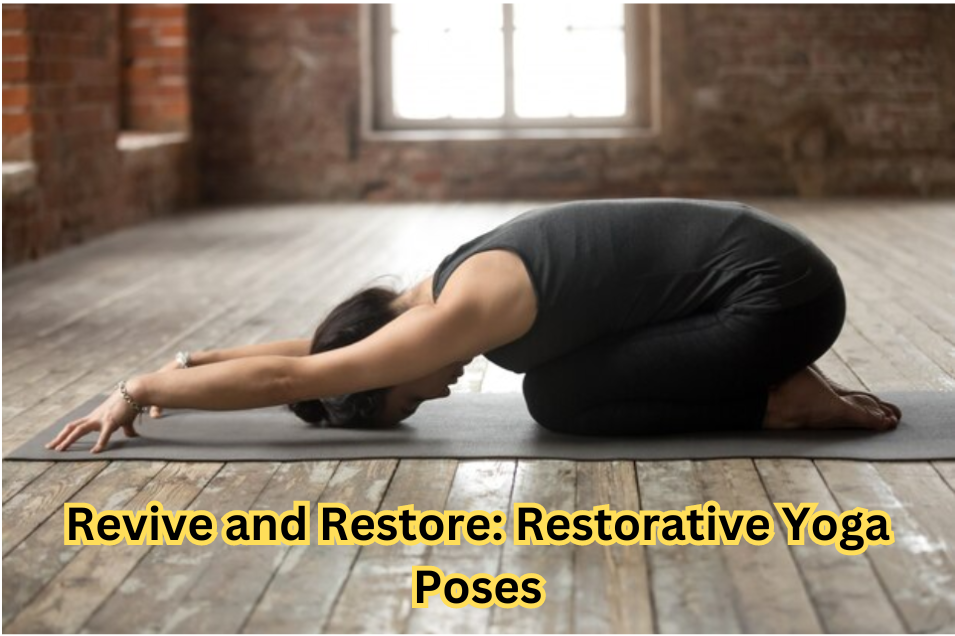Restorative Yoga Poses Step into the quiet realm of beneficial yoga positions, where serenity and renewal intertwine. Discovering tranquility and profound relaxation is priceless in our fast-paced world. A haven of calm in the middle of the mayhem, restorative yoga helps you reconnect with yourself physically and mentally by letting go of stress and tension.

Grasping the Concept of Restorative Yoga
Restorative Yoga Poses Deep relaxation and loving postures are the hallmarks of restorative yoga. It entails settling into a state of total relaxation by holding positions for long durations, usually five to twenty minutes. The main objective is initiating the parasympathetic nervous system, which promotes relaxation and healing.
Key Concepts in Restorative Yoga Positions
Restorative Yoga Poses Using bolsters, blankets, blocks, and straps, beneficial yoga positions are meticulously designed to provide the Body with total ease. By offering soft support, these props make it easier for the Body to let go and submit completely. The main goals are Finding a calm state, letting go of stress, and loosening up one’s muscles and mind.
Yoga Asanas for Restorative Health Supported Child’s Pose
Restorative Yoga Poses Start your yoga practice of relaxation and rejuvenation with the reassuring Supported Child’s Pose. Bend forward at the waist and raise your arms above as you lower your hips to meet your heels, supported by a cushion or pile of blankets between your thighs. This relaxing yoga position stretches the lower back, hips, and thighs and promotes a feeling of calm and stability.
Supta Baddha Konasana, or Reclining Bound Angle Pose
Restorative Yoga Poses In the Reclining Bound Angle Pose, you may relax deeply. Get prone and prop up your spine with a cushion or bolster. Join your big toes and little toes, letting your knees loosen. With a light opening of the hips and groin, this posture encourages deep relaxation.
Bridge Pose with Support (Setu Bandha Sarvangasana)
Supported Bridge Pose is a calming backbend. To achieve a mild arch in your lower back, place a block or bolster under your sacrum and raise your hips. Relax your nervous system and lengthen your chest, neck, and spine in this soothing yoga position.
Relaxing Yoga Poses and Their Advantages
Restorative yoga is wonderful because it has many uses. These poses have several benefits beyond just making you feel better right away:
Relief from tension: Restorative yoga positions promote mental peace by inducing a relaxation response, reducing anxiety and tension.
Restoring the Body Physically: They help the Body’s tired muscles heal, increase blood flow, and release pent-up stress.
Restorative yoga encourages self-reflection and mindfulness, emphasizing long holds and conscious breathing, which strengthen the bond between the mind and Body.

Adding Restorative Yoga to Your Everyday Routine
Adding restorative yoga to your regimen won’t require much practice time. Benefits might be noticeable with as little as a few minutes a day. Here are some pointers to help you include restorative postures into your routine:
Establish a Haven: Pick a peaceful area where you may train undisturbed.
Create a relaxing Ambience by turning down the lights, putting on some mellow music, and lighting a candle.
Prioritize Self-Care: Practice restorative yoga to take care of yourself by permitting yourself to relax deeply.
In summary
A sanctuary of tranquility amid our chaotic lives, restorative yoga postures lead the way to profound relaxation and revitalization. Try these mild yet effective yoga positions to reawaken your Body and mind and get your life back on track.
FAQ:
Here, you will find “Revive and Restore: Restorative Yoga Poses,” an all-inclusive guide to restorative yoga, where you may relax and rejuvenate. To assist you in beginning your path to relaxation and self-discovery, we’ve compiled a list of frequently asked questions (FAQs) on restorative yoga postures.
How are Restorative Yoga Poses Different from Regular Yoga Poses?
Unlike traditional yoga, which typically involves greater movement and participation, restorative yoga emphasizes profound relaxation via lengthy passive stays. To facilitate total relaxation, restorative postures use props to support the Body.
Are Restorative Yoga Poses Suitable for Beginners?
Sure thing! Everyone can practice restorative yoga postures since they are easy and soothing. They are a great way for newcomers to yoga to ease into the practice without sacrificing any benefits.
Can Restorative Yoga Poses Help with Stress Relief?
Sure thing. One of restorative yoga’s main draws is how it helps alleviate stress. These positions can help you relax and unwind by activating your Body’s natural relaxation response.
How Long Should I Hold Restorative Yoga Poses?
The time might be anything from five to twenty minutes, depending on the stance. Let your Body sink into the posture and relax deeply; that’s the main goal.
Do I Need Special Equipment for Restorative Yoga?
Having blankets, bolsters, blocks, and straps on hand is helpful, but you may also make do with common household objects. Making sure the Body is well-supported in every position is the main goal.
Are Restorative Yoga Poses Helpful for Physical Recovery?
In a word, yes. In addition to helping the body release stress, these positions boost circulation, which in turn helps tired muscles recuperate.
Can Restorative Yoga Poses Help Improve Sleep Quality?
Indeed, engaging in restorative yoga in the hours leading up to bedtime may have a calming effect on the Body and mind, which in turn may enhance the quality of sleep one gets.
How Often Should I Practice Restorative Yoga Poses?
Regularity is less important than consistency. You can feel better with only a few minutes of relaxing yoga daily. Strive for consistency in your routine.

